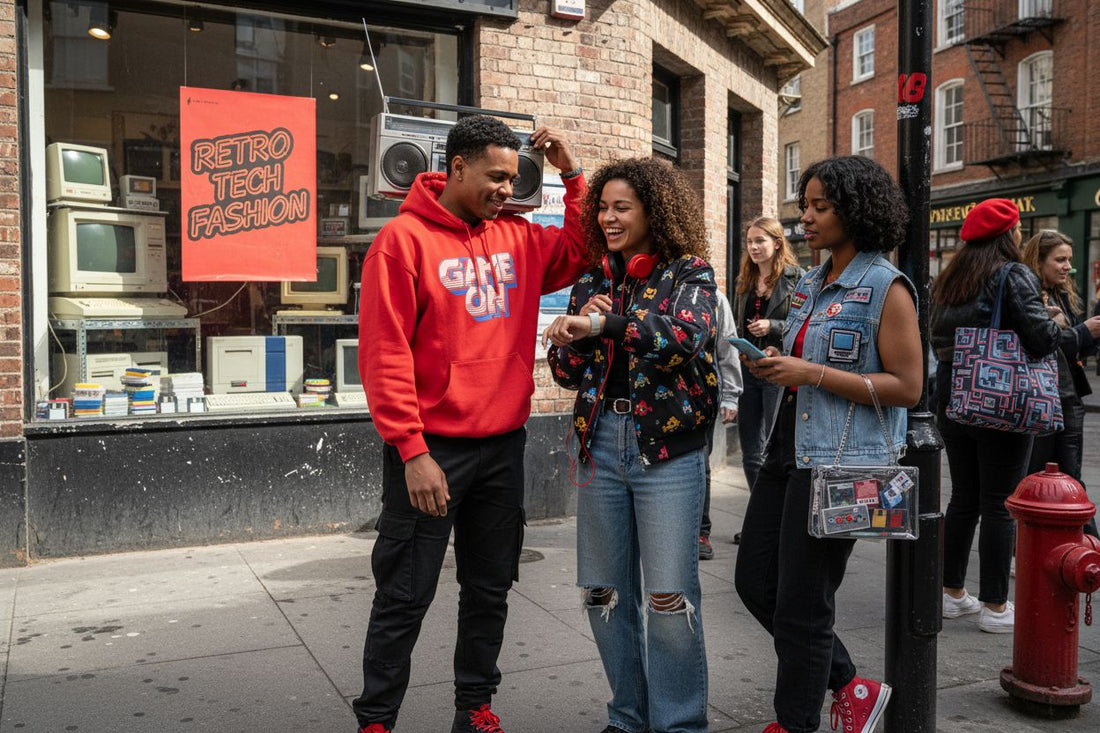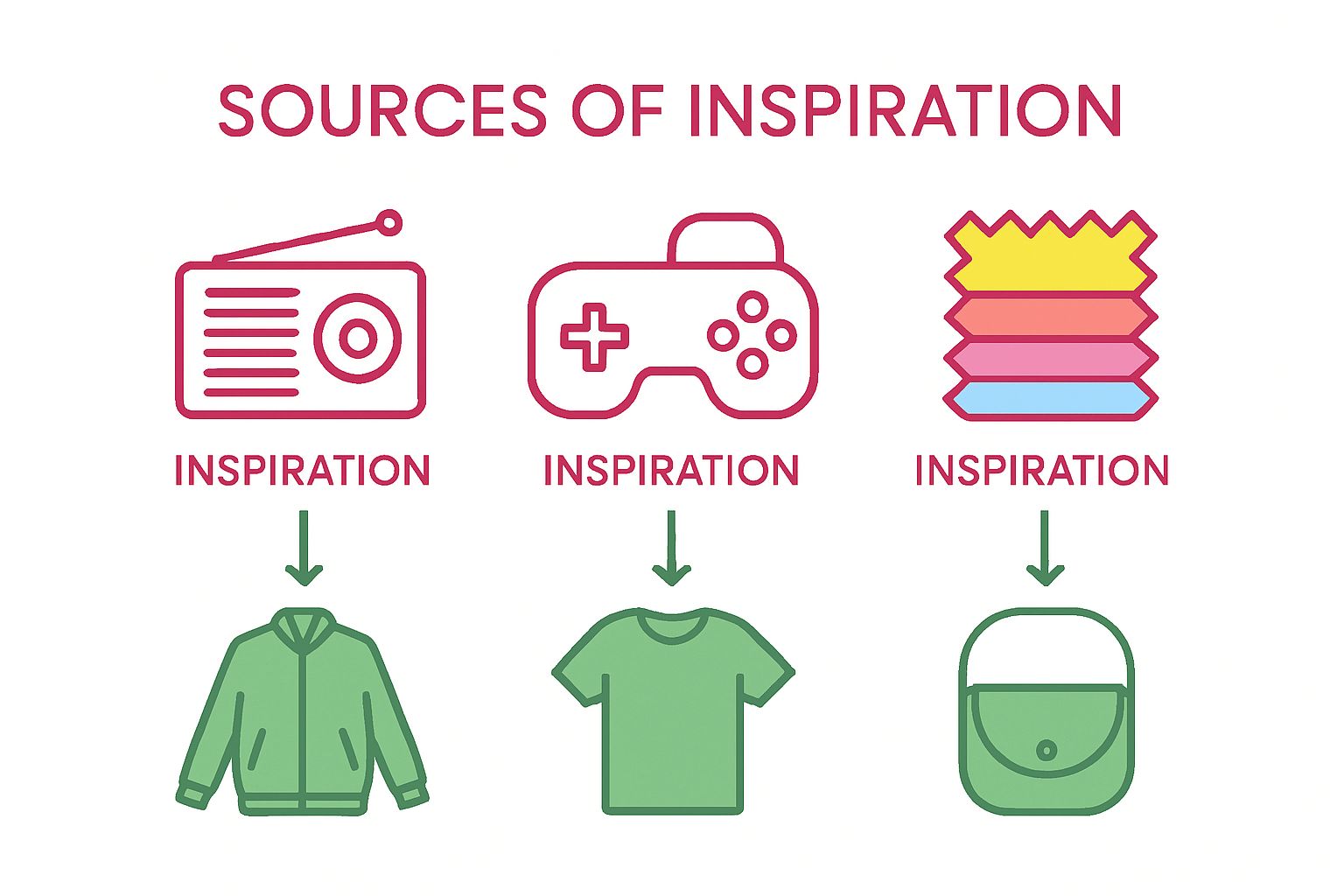
Understanding How Retro Tech Influences Fashion Choices
Share
Retro tech is making waves in fashion circles and you would not believe how much old gadgets shape what is considered cool today. You might expect nostalgia to be a quiet nod in the corner of a thrift shop. But in reality, nearly 60 percent of modern designers say vintage tech directly inspires their latest collections. That means those chunky old cellphones and wild computer colours are not just memories, but bold statements walking down fashion runways right now.
Table of Contents
- What Is Retro Tech And Its Connection To Fashion
- The Cultural Impact Of Nostalgia In Fashion Trends
- How Retro Tech Shapes Contemporary Design Aesthetics
- Key Examples Of Retro Tech In Modern Fashion
- The Future Of Fashion: Blending Retro Tech With Innovation
Quick Summary
| Takeaway | Explanation |
|---|---|
| Retro tech influences modern fashion. | Vintage devices bring nostalgic aesthetics that shape style choices today. |
| Designers leverage nostalgia for storytelling. | Incorporating retro elements communicates personal identity and cultural heritage through fashion. |
| Nostalgia triggers emotional connections. | Nostalgic fashion evokes positive memories, enhancing comfort and connection through style choices. |
| Retro tech informs design evolution. | Historical technological aesthetics are reinterpreted into contemporary design, blending past and present creatively. |
| Future fashion merges nostalgia with innovation. | Evolving designs incorporate adaptive technologies, creating garments that reflect both past influences and future possibilities. |
What is Retro Tech and Its Connection to Fashion
Retro tech represents a fascinating intersection between technological nostalgia and contemporary style, where vintage electronic devices and design aesthetics from past decades influence modern fashion choices. These technological artifacts from previous eras are not merely relics but powerful symbols of cultural identity and personal expression.
Understanding Retro Tech’s Cultural Significance
Retro tech encompasses technological devices and design elements originating from specific historical periods, typically spanning the 1960s through the 1990s. These items are characterized by distinctive visual characteristics such as bold geometric shapes, vibrant color palettes, and innovative mechanical or electronic interfaces. According to Smithsonian Magazine’s Technology Research, technological artifacts from past decades continue to inspire contemporary designers across multiple creative disciplines.
Key characteristics that define retro tech include:
The table below highlights key characteristics that define retro tech, making it easier to understand how these features influence both culture and contemporary fashion design.
| Characteristic | Description |
|---|---|
| Unique mechanical design elements | Distinct shapes and mechanics iconic to their era |
| Distinctive colour schemes | Bold, vibrant palettes typical of specific decades |
| Material textures | Unusual surfaces, plastics, and metals reflecting the times |
| Technological innovations | Pioneering functionality unique to the period |
| Strong aesthetic appeal | Designs that are visually memorable beyond their utility |
- Unique mechanical design elements
- Distinctive color schemes and material textures
- Technological innovations representative of their specific era
- Strong aesthetic appeal that transcends functional utility
Fashion’s Relationship with Technological Nostalgia
The connection between retro tech and fashion runs deeper than mere aesthetic appreciation. Modern fashion designers and enthusiasts view vintage technological artifacts as powerful storytelling tools that communicate personal identity, cultural heritage, and individual creativity. By incorporating elements from classic gadgets into clothing, accessories, and styling choices, individuals express a nuanced narrative about their relationship with technological progress.
Fashion has increasingly embraced retro tech as a form of personal branding, where vintage technological accessories serve as conversation starters and unique style statements. From circuit board printed textiles to accessories inspired by classic gaming consoles, the fusion of technology and fashion creates a dynamic visual language that celebrates both innovation and nostalgia.
The transformative power of retro tech in fashion lies in its ability to bridge generational experiences, allowing individuals to simultaneously honor technological history while expressing contemporary personal style. This dynamic interplay continues to reshape how we understand the relationship between technological artifacts and personal aesthetic choices.
The Cultural Impact of Nostalgia in Fashion Trends
Nostalgia represents a powerful emotional force that transcends mere reminiscence, actively shaping contemporary fashion trends and consumer behaviors. This psychological phenomenon transforms historical technological and design elements into meaningful cultural expressions that resonate deeply with individuals seeking connection and identity through style.
Psychological Roots of Nostalgic Fashion
The emotional landscape of nostalgia is complex, functioning as a mechanism for personal and collective memory preservation. Research from Consumer Psychology indicates that nostalgic experiences trigger positive emotional responses, allowing individuals to reconnect with perceived safer, more comfortable historical periods. In fashion, this translates to a deliberate selection of styles, accessories, and design elements that evoke memories of specific technological eras.
Key psychological drivers of nostalgic fashion trends include:
- Emotional comfort during periods of social uncertainty
- Desire to establish personal and generational identity
- Romanticization of past technological and cultural experiences
- Seeking meaningful connections through shared cultural memories
Technological Nostalgia as Cultural Expression
Fashion serves as a powerful medium for expressing technological nostalgia, where vintage design elements become symbolic representations of cultural experiences. By incorporating retro technological aesthetics, individuals communicate complex narratives about their relationship with technological progress, personal history, and social identity.
The phenomenon extends beyond mere aesthetic appreciation, transforming nostalgic consumer behaviors into sophisticated forms of personal storytelling. Designers and fashion enthusiasts strategically leverage historical technological references to create unique style statements that simultaneously honor past innovations and challenge contemporary aesthetic norms.
Ultimately, nostalgic fashion trends reveal more than stylistic preferences. They represent intricate cultural dialogues about technological evolution, generational experiences, and the continuous reinterpretation of historical design vocabularies. Through carefully curated technological references, individuals construct nuanced personal narratives that bridge past experiences with contemporary identities.
How Retro Tech Shapes Contemporary Design Aesthetics
Contemporary design aesthetics increasingly draw inspiration from technological artifacts of past decades, transforming nostalgic elements into sophisticated visual languages that communicate complex cultural narratives. This integration of historical technological design represents a nuanced approach to understanding aesthetic evolution and cultural memory.
Design Principles of Technological Nostalgia
Retro tech fundamentally influences design aesthetics by reinterpreting historical technological forms through modern creative perspectives. Design Research Institute suggests that designers are increasingly viewing vintage technological artifacts not as obsolete objects but as rich sources of aesthetic inspiration, extracting unique visual vocabularies that challenge contemporary design conventions.
Critical design principles driving retro tech aesthetic integration include:
- Preservation of original technological form language
- Reimagining mechanical and electronic design elements
- Celebrating material textures and color palettes from specific historical periods
- Creating meaningful dialogues between past and present design philosophies
Translating Technological Heritage into Visual Narratives
Designers strategically decode historical technological artifacts, extracting essential visual characteristics that communicate deeper cultural meanings. By incorporating retro design trends into contemporary aesthetic approaches, creative professionals construct complex visual narratives that transcend simple nostalgic reproduction.
The translation process involves sophisticated deconstruction and reinterpretation of technological design elements. Circuit board geometries become textile patterns, vintage computer color schemes inspire contemporary fashion palettes, and mechanical interfaces transform into architectural and product design motifs. This approach allows designers to create layered aesthetic experiences that simultaneously honor technological heritage and push creative boundaries.
Ultimately, retro tech’s influence on design aesthetics represents a dynamic dialogue between technological history and contemporary creative expression. By thoughtfully engaging with historical design vocabularies, designers create visual experiences that invite audiences to reexamine their relationship with technological progress and cultural memory.

Key Examples of Retro Tech in Modern Fashion
Modern fashion has become a vibrant canvas for technological nostalgia, where vintage electronic devices and design elements are transformed into sophisticated style statements that communicate complex cultural narratives. These creative translations bridge generational experiences and technological memories through innovative aesthetic expressions.
Wearable Technology and Nostalgic Design
Smithsonian Magazine’s Technology Trends reveals that contemporary designers are strategically reinterpreting technological artifacts from past decades into wearable art forms. Digital watches reminiscent of 1980s calculator models, circuit board printed textiles, and accessories inspired by vintage computing aesthetics represent powerful examples of this transformative design approach.
Significant categories of retro tech fashion integration include:
Below, you will find a comparison of how retro tech inspires different aspects of modern fashion, detailing both design approaches and their cultural significance for South African consumers.
| Aspect | Role of Retro Tech | Impact on Fashion |
|---|---|---|
| Personal Accessories | Mimics designs of vintage electronic devices | Distinctive, nostalgic focal points |
| Textile Patterns | Incorporates circuit board and hardware schematics | Adds visual intrigue, tech nostalgia |
| Colour Palettes | Draws from classic computer and gadget hues | Retro look, ties fashion to tech era |
| Jewellery/Decor | Features mechanical and electronic components as design motifs | Celebrates innovation and heritage |

- Personal accessories mimicking vintage electronic device designs
- Textile patterns derived from technological schematics
- Color palettes inspired by historical computing interfaces
- Jewelry and decorative elements referencing mechanical components
Technological Iconography in Contemporary Styling
Fashion designers are increasingly viewing technological artifacts as rich visual vocabularies, extracting intricate design languages that communicate deeper cultural meanings. By incorporating elements from obsolete technologies, they create narratives that challenge traditional aesthetic boundaries. Electronic components transformed into jewelry, vintage computer color schemes reimagined as fabric textures, and mechanical interface geometries translated into clothing silhouettes exemplify this creative reinterpretation.
The phenomenon extends beyond mere visual reproduction, with vintage gadget inspirations serving as powerful tools for personal expression. Individuals strategically select technological references that reflect their generational experiences, professional identities, and creative sensibilities.
Retro tech in fashion represents more than aesthetic nostalgia. It is a sophisticated dialogue between technological progress, cultural memory, and individual creativity.
The Future of Fashion: Blending Retro Tech with Innovation
The intersection of technological nostalgia and forward thinking design represents a sophisticated evolution in contemporary fashion, where historical aesthetic references merge seamlessly with cutting edge technological capabilities. This dynamic fusion creates a revolutionary approach to personal style that transcends traditional design boundaries.
Emerging Design Paradigms
Future Design Institute suggests that future fashion will increasingly integrate adaptive technologies with nostalgic design elements, creating garments and accessories that are simultaneously retrospective and progressive. Smart textiles embedded with vintage computing color palettes, interactive clothing featuring mechanical interface inspirations, and wearable technologies that reference historical electronic aesthetics exemplify this emerging design philosophy.
Key technological integration strategies include:
- Adaptive materials mimicking vintage technological textures
- Interactive clothing with embedded electronic references
- Sustainable design approaches inspired by historical technological efficiency
- Personalization technologies drawing from retro aesthetic languages
Technological Convergence in Personal Style
The future of fashion represents a profound dialogue between human creativity and technological innovation. Designers are no longer simply referencing past technological artifacts but actively reimagining them through sophisticated design approaches that challenge conventional aesthetic boundaries. Circuit board geometries become intelligent fabric structures, vintage computing color schemes transform into responsive textile technologies.
This approach extends beyond visual aesthetics, with innovative retro design concepts serving as fundamental frameworks for understanding how technological heritage can inform future design strategies. By thoughtfully integrating historical technological references with contemporary innovation, designers create experiences that are simultaneously nostalgic and transformative.
Ultimately, the convergence of retro tech and fashion innovation represents more than a design trend. It is a profound cultural dialogue about technological progress, personal identity, and the continuous reinterpretation of human creativity through design. As technological capabilities expand, fashion becomes a dynamic canvas for exploring our complex relationship with innovation and memory.
Bring Retro Tech Style into Your Everyday Life
Are you inspired by the way retro tech fuels modern fashion and want your personal style to reflect that same sense of nostalgia and innovation? The article highlights how connecting with vintage designs is about more than just looking good. It is about making an emotional statement and owning your identity. If you struggle to find truly authentic retro-inspired gadgets and accessories that match your love for classic tech and fashion, you are not alone. Many South Africans face the challenge of sourcing unique, high-quality items that let them express both their personality and their passion for the past.
The good news is, your search for that perfect blend of old-school cool and modern practicality can end here. Explore a curated range of tech-inspired watches, device cases, gaming products and more at OnlyRetro, where vintage aesthetics meet everyday functionality. Discover products that let you turn inspiration into reality. Why wait when you can level up your look and start living that nostalgic dream today? Visit OnlyRetro’s homepage now to browse the collection and find your perfect retro tech accessory.
Frequently Asked Questions
What is retro tech?
Retro tech refers to technological devices and design elements from past decades, typically from the 1960s to the 1990s, that influence modern aesthetics and fashion choices.
How does retro tech influence fashion design?
Retro tech influences fashion design by providing unique visual characteristics, such as distinct shapes, vibrant colors, and nostalgic elements that modern designers incorporate into their collections to create stylish and meaningful narratives.
Why is nostalgia important in fashion?
Nostalgia is important in fashion as it allows individuals to reconnect with past cultural experiences, evoking positive emotions and identities through the incorporation of vintage styles and technological references in their personal attire.
What are some examples of retro tech in modern fashion?
Examples of retro tech in modern fashion include digital watches reminiscent of 1980s models, textiles featuring circuit board patterns, and accessories inspired by vintage gaming consoles, all of which channel nostalgic aesthetics into contemporary design.
Recommended
- What is Retro Tech? Discover Vintage Gadgets in 2025 – OnlyRetro
- Understanding Exploring Retro Style Trends for Collectors – OnlyRetro
- Retro Design Trends 2025: Vintage Style Meets Modern Tech – OnlyRetro
- Understanding Why Retro Style is Trending in Modern Culture – OnlyRetro
- Understanding What Are Retro Baseball Tees and Their Appeal – ChillStitchApparel
- How trends in fashion are born, live and die - Corrado Manenti